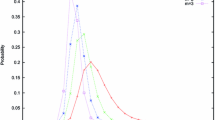Abstract
Distributions of runs of length at least k (Type II runs) and overlapping runs of length k (Type III runs) are derived in a unified way using a new generating function approach. A new and more compact formula is obtained for the probability mass function of the Type III runs.
Similar content being viewed by others
References
Balakrishnan, N., Koutras, M. V. (2002). Runs and scans with applications. New York, NY: Wiley.
Flajolet, P., Sedgewick, R. (2009). Analytic combinatorics. New York, NY: Cambridge University Press.
Fu, J. C., Koutras, M. V. (1994). Distribution theory of runs: A Markov chain approach. Journal of the American Statistical Association, 89, 1050–1058.
Hirano, K., Aki, S. (1993). On number of occurrences of success runs of specified length in a two-state Markov chain. Statistica Sinica, 3, 313–320.
Kong, Y. (2006). Distribution of runs and longest runs: A new generating function approach. Journal of the American Statistical Association, 101, 1253–1263.
Kong, Y. (2014). Number of appearances of events in random sequences: A new approach to non-overlapping runs. Communications in Statistics-Theory and Methods (To appear).
Kong, Y. (2015). Distributions of runs revisited. Communications in Statistics-Theory and Methods, 44, 4663–4678.
Koutras, M. (1997). Waiting times and number of appearances of events in a sequence of discrete random variables. In N. Balakrishnan (Ed.), Advances in combinatorial methods and applications to probability and statistics (pp. 363–384). Boston, MA: Birkhäuser.
Koutras, M. V., Alexandrou, V. A. (1995). Runs, scans and urn model distributions: A unified Markov chain approach. Annals of the Institute of Statistical Mathematics, 47(4), 743–766.
Mood, A. M. (1940). The distribution theory of runs. Annals of Mathematical Statistics, 11, 367–392.
Petkovsěk, M., Wilf, H. S., Zeilberger, D. (1996). A = B. Wellesley, MA: A K Peters Ltd.
Acknowledgments
This work was supported in part by the Clinical and Translational Science Award UL1 RR024139 from the National Center for Research Resources, National Institutes of Health.
Author information
Authors and Affiliations
Corresponding author
Electronic supplementary material
Below is the link to the electronic supplementary material.
Appendix: Proof of Lemma 1
Appendix: Proof of Lemma 1
In this Appendix, we give the proof of Lemma 1.
Proof
Using the Wilf–Zeilberger method (Petkovsěk et al.1996), we can obtain the following linear recurrence equation for \(S_m\):
To get explicit form of \(S_m\), first assume that \(v-2 \ge u-1\). From the recurrence we have
When \(m=v-2\), there is only one term in the sum, which leads to
After substitution of \(S_{v-2}\) and rearrangements, the identity in Eq. (8) of Lemma 1 is obtained for the case when \(v-2 \ge u-1\) and \(m \ge 0\). If we assume \(v-2 < u-1\), the same result is obtained for \(m \ge 0\). In this case the recurrence ends with \(m=u-1\), and we use the identity
to get the explicit form of \(S_m\).
The case of \(m=-1\) is trivial since in this case the only value u can take is \(u=0\); hence, the sum involves only one term when \(r=-1\). This further restricts the values of v, which can only take \(v=0\) or \(v=1\) for the sum to take nonvanishing value. \(\square \)
About this article
Cite this article
Kong, Y. Number of appearances of events in random sequences: a new generating function approach to Type II and Type III runs. Ann Inst Stat Math 69, 489–495 (2017). https://doi.org/10.1007/s10463-015-0549-2
Received:
Revised:
Published:
Issue Date:
DOI: https://doi.org/10.1007/s10463-015-0549-2



